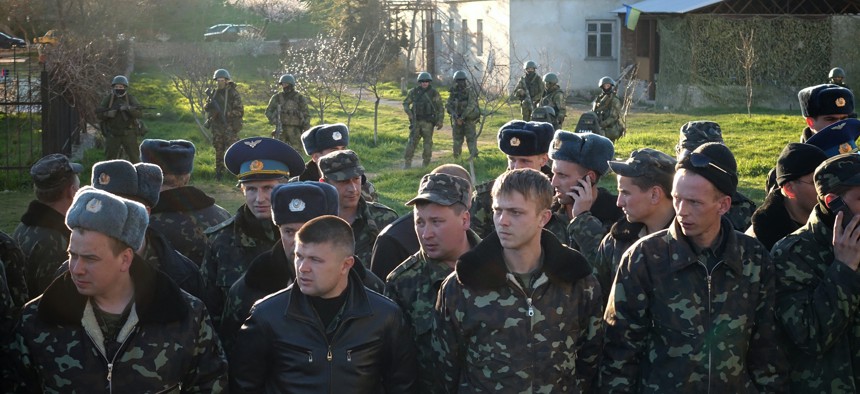
The Ukrainian soldiers and officers of the Ukrainian Belbek Airbase, which was seized by Russian special forces on March 22, 2014 near Belbek, Crimea. Oleg Klimov / Epsilon / Getty Images
Here’s What DOD’s International Security Nominee Learned from Russia’s 2014 Seizure of Crimea
Send weapons faster, and prepare to boost U.S. forces in the region, Celeste Wallander told lawmakers.
The Biden administration must learn lessons from the slow U.S. response to Russia’s 2014 invasion of Crimea: it must be prepared to send weapons to Kiev faster and, potentially, to boost NATO troop presence in the region if Russia attacks, the nominee to lead the Pentagon’s international security office told Congress on Thursday.
Celeste Wallander, who served as the National Security Council’s Russia director in 2014, said any further incursion by Moscow into Ukraine should prompt the Pentagon to reevaluate its presence in the region and its contributions to NATO, including potentially expanding the alliance’s Enhanced Forward Presence brigades in Estonia, Latvia, Lithuania and Poland.
“In principle, I would support an increased American at least rotational presence in that region,” Wallander told Sen. Marsha Blackburn, R-Tenn., who asked about sending more EFP brigades further south in Eastern Europe.
The Enhanced Forward Presence brigades were established in 2016 in response to Russia’s seizure of the Crimean peninsula. Each country’s brigade includes troops from multiple NATO nations. American troops lead the brigade in Poland.
A senior administration official told reporters in December that the government is working with allies on a plan to respond to a potential Russian invasion, which could include boosting the number of troops in countries on NATO’s eastern flank.
Although she served on the NSC during the crisis, Wallander criticized the Obama administration’s response as “too slow and too incremental.” Asked by Sen. Tom Cotton, R-Ark., if it was a mistake not to give Ukraine Javelin anti-tank missiles more quickly after Russia annexed Crimea, Wallander said it was.
“One of the lessons I learned is that it would have been appropriate and necessary to provide Ukraine with what it needed to defend its territory, including the weapons you suggest,” said Wallander, who also served as the deputy assistant defense secretary for Russia, Ukraine, and Eurasia from 2009 to 2012.
There has been much debate about whether to give offensive weapons to Ukraine. While the capabilities would allow Ukraine to better protect itself, Russian President Vladimir Putin has called it a “red line” that could spark military retaliation from Moscow.
Wallander said she would “not rule them out,” but added that she would not make any firm commitments until she had been confirmed and fully briefed on the classified assessment of Russia’s capabilities and Ukraine’s requirements.
She also said she’s looking for European allies to do more to protect the continent and go beyond the promise made in 2014 to spend at least 2 percent of gross domestic product on defense by 2024. But she said she’s not prepared to recommend that the United States cut its military presence in Europe to encourage allies to spend more themselves to fill that gap and free up American dollars to counter China.
“As we face a heightened threat from Russia, this would not be the moment to put a reduction in American commitment to NATO on the table, but what I would favor, if confirmed, is looking at how the United States can provide some of its advantages in enablers, in weapons systems, in security cooperation with allies to ensure that we are properly resourcing the requirements in the Indo-Pacific…and yet sustaining defensive deterrence against Russia,” she said.




